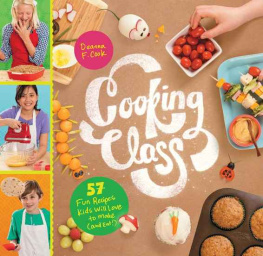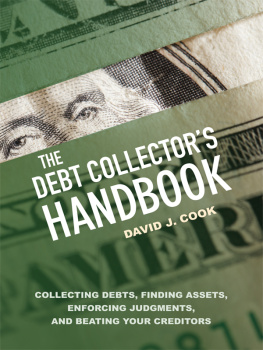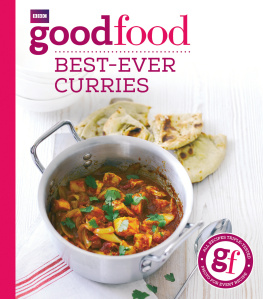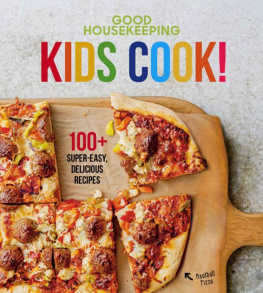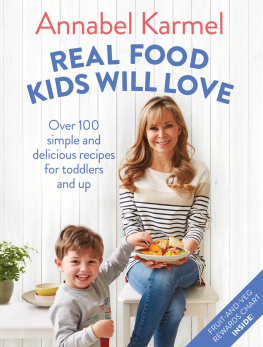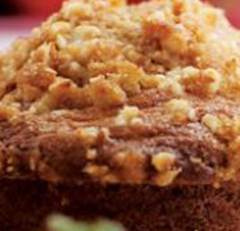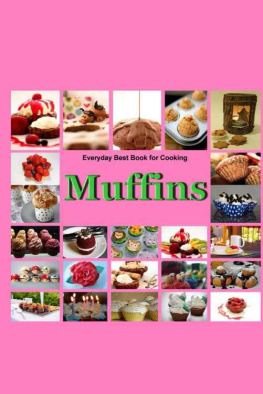Dedicated to my girls,
Ella & Maisie
Hello, Cooking Friends!
Im happy you picked up a copy of Cooking Class and that youre ready to start cooking! When I was your age, I loved looking at cookbooks and finding new recipes to try (with the last name of Cook, I grew up thinking, I should cook!). My own two daughters like to spend time in the kitchen with their friends, and they inspired me to collect the recipes in this cookbook. I hope you like the recipes as much as they do.
We also cooked up all the food for the photography that you see on every page. It was fun working with so many great kids, and I want to thank them all for their time and for the yummy food they made. Thank you, Abby, Adia, Alex, Arden, Aria, Ariana D., Arianna R.F., Asha, Audrey, August, Brady, Caleb, Chloe, Christian, Conor, Ernnie, Ella, Finn, Grace, Inez, Iris, James, Jimmy, Kelly, Lauren, Louisa, Maddie, Maisie, Margaux, Mia, Nat, Phin, Reyna, Rohin, Ruby, Sarah, Seth, Silas, Sophie C., Sophie M., Tate, Teagan, Teddy, Theo, Wallace, Wiley, and Zadie.
Lastly, I want to thank the team at Storey who helped me with this beautiful book, especially Jessica Armstrong, Lisa Hiley, and Deborah Balmuth, and our photographer, Julie Bidwell.
Happy Cooking!
Contents
Chapter One
Welcome to Cooking Class!
Do you like to cook? Maybe youve helped your family in the kitchen with dinner or baked brownies for dessert with your friends. Or maybe youre just hungry for a homemade snack. This book is filled with fun and easy recipes that teach kids how to cook. Each recipe was tested by kids just like you for ease (Fast! or Took too long!), taste (Yum! or Yuck!), and overall fun factor.
Before you put on your apron, take some time to read this introductory chapter all the way through. It has helpful tips for junior chefs, like what kitchen tools to have on hand and how to measure carefully. It also shows you how to properly use a paring knife and other ways to be safe in the kitchen. But most important, youll learn how to cook up some fun in the kitchen!

Recipe Ratings
Each recipe is rated with one, two, or three spoons so you know the skill level needed to complete it. If you are a new chef, you can start with the easier recipes and work your way up.
You can cook most of these recipes without needing a hot stove or using a sharp knife.
You need to do some prep work, such as chopping or dicing. Youll also try out new kitchen skills. These are good recipes to work on with a parent or older sibling.
These recipes involve cutting with sharp knives and using the oven and stovetop. They tend to take more time to prepare, too. If you are just learning to cook, work with an adult.
Lesson 1 Review the Rules
Start good cooking habits from the get-go by following these basic kitchen rules. Ask an adult for permission to make a recipe. Ask for help, too, if you have questions along the way.
- Wash your hands with warm water and soap before you handle food. Scrub well for 20 seconds, or as long as it takes to recite the alphabet.
- Roll up long sleeves and wear an apron or smock (an oversize T-shirt will do the trick nicely). Tie back long hair to keep it away from food. You can even wear a bandanna or chefs hat!
- Read the recipe from start to finish before you begin. Follow the steps closely.
- Put out all the ingredients from the Heres What You Need list to be sure you have everything.
- Measure carefully (see the tips in ).
- Use a timer so you dont burn or overcook anything.
- Always use pot holders when touching hot pans and dishes.
- Most important, clean up afterward!
Lesson 2 Get Your Kitchen in Order!
Make a Recipe Collection
Start with the recipes in this book put a check mark next to each one you try. You can also create your own folder or recipe box for storing recipes from magazines and websites. Use the recipe cards in the back of the book to write down some favorite family recipes or ones that you come up with yourself.
Create a Cooking Kit
Find a box or clear plastic container and stock it with your own cooking tools. Label or decorate your container. (Download and print the stickers here http://whol.st/cc-stickers .)
Youll want to start with:
- measuring spoons & cups
- whisk
- paring knife
- rolling pin
- clean scissors
- mixing spoon
- spatula
- tongs
- pastry brush
- melon baller
- pizza cutter
Set Up a Good Work Space
- Clear off a kitchen countertop so you have plenty of room to cook. A kitchen table is a great place to prep food, too.
- If the work space is too high for you to comfortably reach, find a sturdy stool to stand on.
- Be sure the floor isnt wet you dont want to slip and fall!
Lesson 3 Start with Good Ingredients
Make a list before you shop. This will save you time and money, and you wont forget an important ingredient.
Use fresh ingredients as much as possible. Whenever you can, choose organic fruits and veggies. They taste great, have more nutrients, and are better for the environment.
Pick your own. If youre lucky enough to have a garden, you can pick veggies for your recipes. If not, stop at your nearest farmers market to stock up. These markets usually also sell meats, cheeses, and eggs that are organic and/or local. During the winter, though, frozen vegetables often taste better and have more nutrients than fresh ones shipped from far away.
Store your produce properly until you use it, and clean it well before cooking. Rinse fruits and vegetables under cold water to remove any dirt. Use a scrub brush on hard items like carrots and potatoes to make washing them easier.

Silas and Wiley pick out fresh fruits and veggies at the farmers market in their town. When you visit your farmers market, dont forget to bring your own bags!

